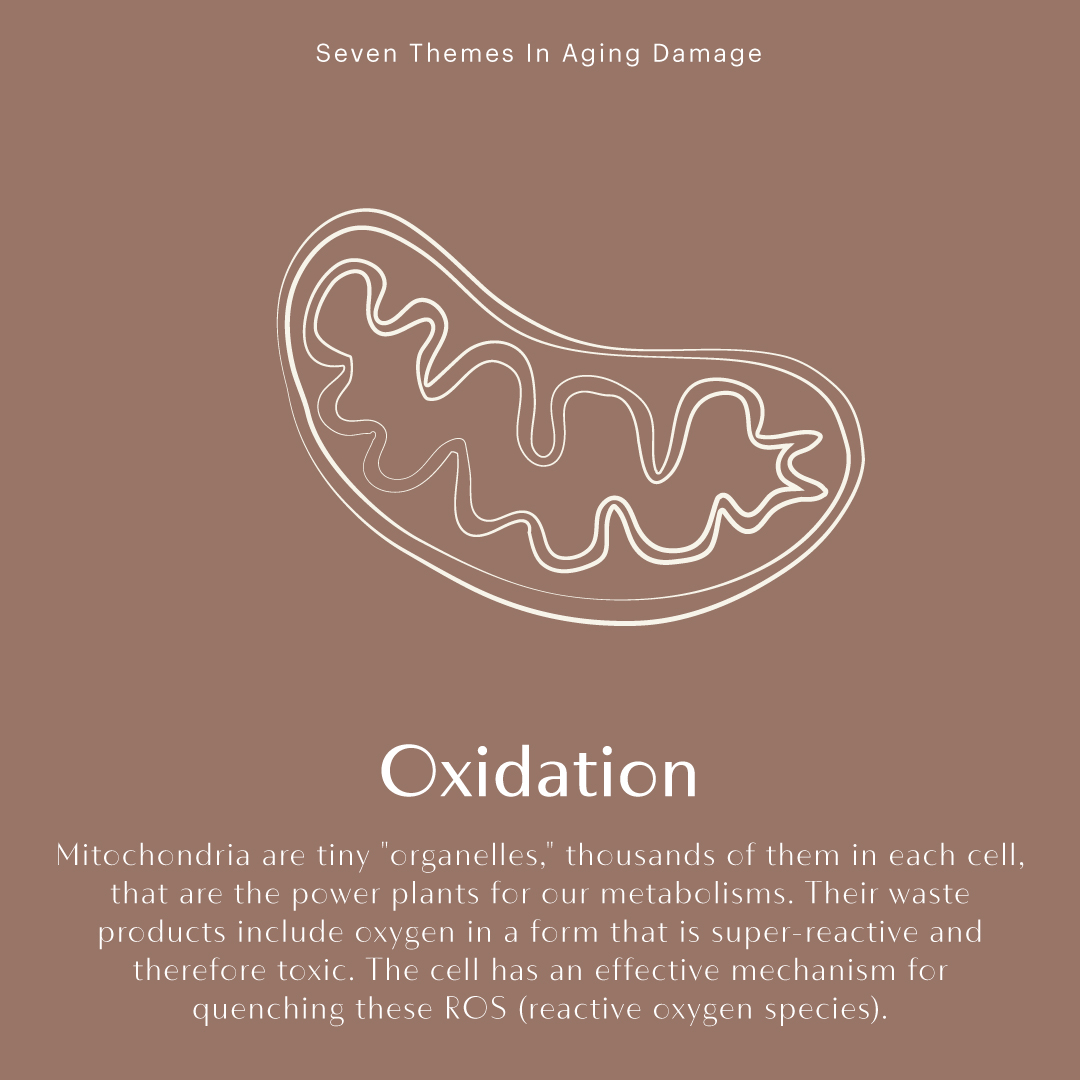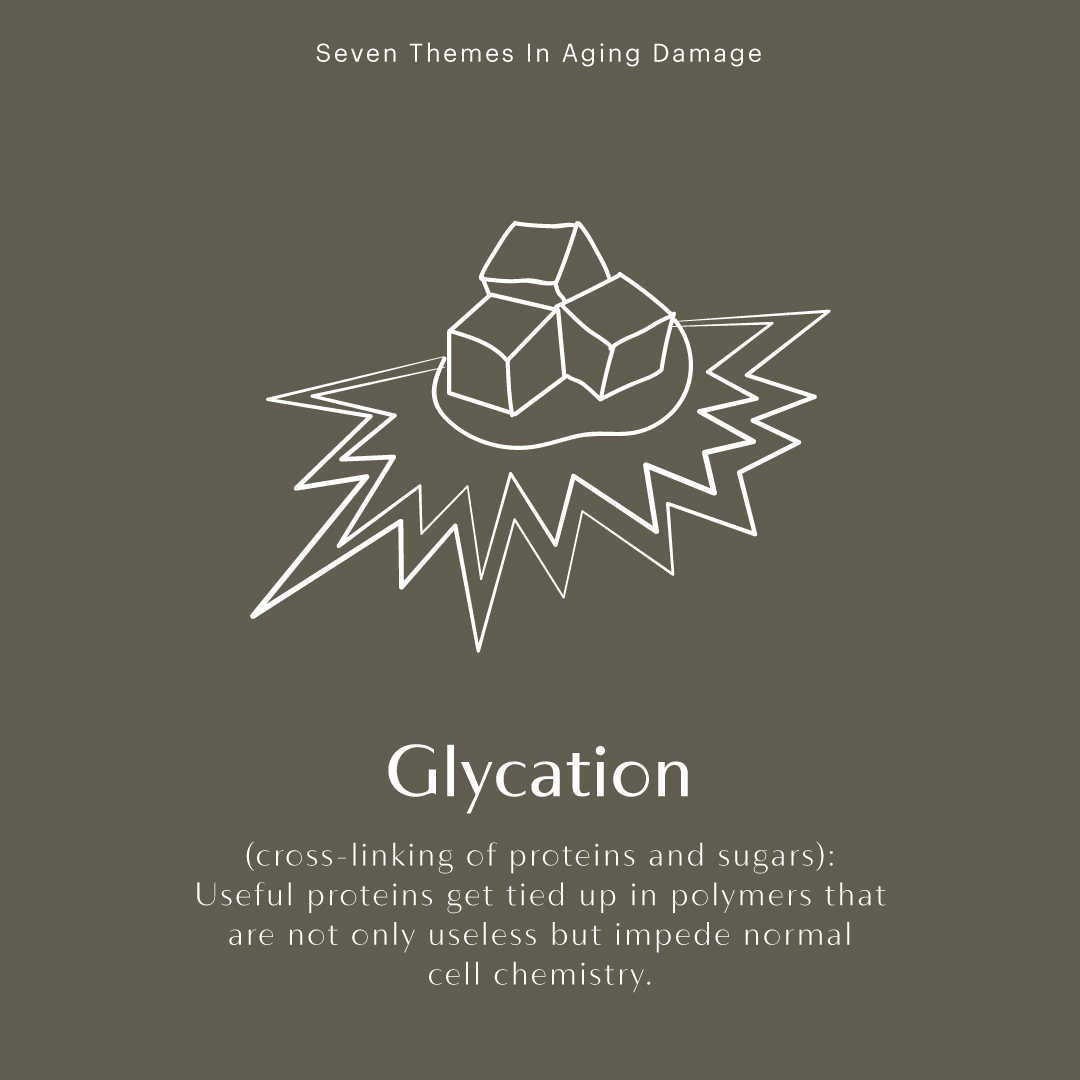HELLO informed beauty!
Living in a NEW AGE of biohacking, energetic medicine and advanced genetic testing - we are so blessed to have the immense amount of research - solutions and experts we have today to help us feel, look and be are best as we age.
Today, I’m going to geek out and share the latest research on - ACCELERATED aging, hows its measured and what you can do about it.
READY? Let’s jump in.
This article outlines recent research within epigenetic and aging clocks – predictors of biological age based on alterations in a person's DNA methylation profile.
Methylations are biochemical processes that modify the activity of a DNA segment without changing its sequence. They occur naturally and regulate gene expression to control normal growth and development.
With age, the methylation state of various DNA sites (often enriched in genes that govern processes like cell death and survival, cellular growth and proliferation, organismal and tissue development, and cancer) may change. These methylation changes are quantifiable and serve as a means to gauge biological age, which is often different from chronological age.
Put another way, we all know that one person who looks great for their age. Some of these hard-to-quantify qualities we intuitively see in other people (or even ourselves) when it comes to aging often actually correspond with something that can now be quantified and put to a number via epigenetic testing, allowing us to peek behind the DNA curtain at true biological age.
The term "epigenetic clock" is also a collective designation referring to the natural biological mechanisms that drive DNA methylation.
TICK TOCK - THE POWER OF TELOMERES
Epigenetic clocks are predictors of biological age based on alterations in an individual's DNA methylation profile.
Methylation is a biochemical process that modifies the activity and potential of your DNA without changing its sequence, which occurs naturally and regulates gene expression to control normal growth and development.
As women age, the methylation state of various genes tends to change and are now a way to help professionals to gauge your epigenetic age (infulenced through lifestyle and stress), which often differs from chronological age.
The term "epigenetic clock" refers to the natural biological process that drives your DNA turnover and rebuilding of cellular health. This individual molecular "footprint" for you also reflects the biological life history of you- as a living organism.
The information we’ll go over today focuses primarily on predictive epigenetic clocks, with a brief mention of the innate.
Overview of concepts underpinning epigenetic clocks
Epigenetics
Epigenetics is a biological mechanism that regulates gene expression (how and when certain genes are turned on or off).
I coin this concept as the “80/20” rule. Your diet, lifestyle, personal care beauty products and environmental exposures is the driver of 80% epigenetic changes throughout an individual's lifespan to influence health and disease.
For example, epigenetic processes when dysregulated can result in accelerated aging, diseases such as cancer and Alzheimer's disease.[1][2] Scientific evidence suggests that some genetic changes can be passed from generation to generation, although are mostly influenced by turning “good and bad gene” activity up or down.[3]
Three biochemical processes are thought to drive epigenetic change:
-DNA methylation
-Histone modification
-Non-coding RNA-associated gene silencing.
In conclusion here, the DNA’s ability to fully process through seeing the quality of your methylation, which helps determine the prediction of your biological age via epigenetic clocks.
WHAT IS METHYLATION?
The topic of methylation is getting its fair share of attention lately, and rightly so. Methylation is a simple biochemical process – it is the transfer of four atoms - one carbon atom and three hydrogen atoms (CH3) – from one substance to another.
When optimal methylation occurs, it has a significant positive impact on many biochemical reactions in the body that regulate the activity of the cardiovascular, neurological, reproductive, and detoxification systems, including those relating to:
-DNA production
-Neurotransmitter production
-Detoxification
-Histamine metabolism
-Estrogen metabolism
-Eye health
-Fat metabolism
-Cellular energy
-Liver health
WHY IS METHYLATION IMPORTANT?
The body is a very complex machine, with various gears and switches that need to be all functioning properly to operate optimally. Think of methylation, and the opposite action, demethylation, as the mechanism that allows the gears to turn, and turns biological switches on and off for a host of systems in the body.
HOW DOES METHYLATION HAPPEN?
CH3 is provided to the body through a universal methyl donor known as SAMe (S-adenosylmethionine). SAMe readily gives away its methyl group to other substances in the body, which enables the cardiovascular, neurological, reproductive, and detoxification systems to perform their functions.
If enough 5-MTHF is present, the methylation cycle will work efficiently.
Folic acid from the diet or supplements must be converted to this active form, 5-MTHF, before it can be used in the body in the methylation cycle.
Unfortunately, approximately 60% of people in the United States have a genetic mutation that makes it challenging for their bodies to create enough 5-MTHF.
IMPROVING THE METHYLATION CYCLE
In addition to a healthy, whole-food, non-processed food diet, make sure you are eating a lot of these foods:
Asparagus
Avocado
Broccoli
Brussels sprouts
Green, leafy vegetables
Legumes (peas, beans, lentils)
Rice
Lifestyle changes include:
Engage in regular physical exercise
Avoid excessive alcohol consumption
Don’t smoke
Avoid excessive coffee consumption (not more than five cups daily)
SEVEN ESSENTIAL NUTRIENTS FOR METHYLATION
There are seven specific nutrients that can help the methylation cycle achieve optimal performance, even if an individual has a genetic mutation that slows down the methylation cycle.
5-MTHF (active folate)
Methylcobalamin (active vitamin B12)
Pyridoxal 5’-Phosphate (active vitamin B6)
Riboflavin 5’-Phosphate (active vitamin B2)
Magnesium
Betaine (also known as trimethylglycine)
Vitamin D
Proper methylation influences so many systems in our bodies that it often gets overlooked, which can severely impact how well your body functions. Ask your health-care practitioner for advice if you have any concerns about your CH3 cycle.
Aging
Aging comprises the collective physiological, functional, and mental changes that accrue in a biological organism over time. It is the primary risk factor for many chronic diseases in humans, including cancer, Alzheimer's disease, and cardiovascular disease.
Chronological age
An individual's chronological age simply reflects the number of years an individual has been alive. Although scientific milestones correlate that chronological age is an unreliable measure of the aging process.
Epigenetic age
Epigenetic age is based on an individual's DNA methylation health previously discussed. An individual's epigenetic age strongly correlates with their chronological age. However, some exceptions exist. For example, the epigenetic ages of semi-supercentenarians (people who live to be 105 to 109 years old) are markedly younger than their chronological ages.[10]
Biological age
An individual's biological age, sometimes referred to as phenotypic age, provides a measure of the physiological and functional state. It is a calculation of an individual's risk of disease and death compared to individuals of the same chronological age, based on biochemical measures of inflammation and metabolic and immune function.[11]
Age Acceleration
Age acceleration occurs when an individual's epigenetic age exceeds their chronological age
and may be the result of either intrinsic or extrinsic factors.
Intrinsic factors are largely driven by internal physiological and biological factors such as normal metabolism and genetics.
Extrinsic factors are those associated with lifestyle and environmental exposures, such as diet, chemicals, EMF, UV radiation, and mental health and overall stress.
Each is named for the scientist who created the clock or for the clock's output. The most accurate and robust of these clocks are described here.
Research to Determine Real Time Biological Age
The Hannum clock
Created by Dr. Gregory Hannum, the Hannum clock is a single-tissue calculator of epigenetic age base present in DNA from human blood.[13]
Use of the Hannum clock also demonstrated that exposure to abuse, financial hardship, or neighborhood disadvantage that occurred around the age of 7.5 years alters methylation patterns, which may influence normal patterns of cellular aging.[15]
Another study investigated the effects of cigarette smoking on aging using the Hannum clock based on methylation findings indicated that not only was smoking associated with accelerated biological aging, but even low levels of exposure elicited strong effects.[16]
The Horvath clocks
The original Horvath epigenetic clock, created by Dr. Steven Horvath, predicts age based on methylation patterns and rates in the DNA of 51 different tissue and cell types.[7]
The Horvath clock can identify the epigenetic age of a donor with 96 percent accuracy within approximately four years of actual age.[7] Its accuracy extends across multiple tissue types and ages, including children.
Diet and lifestyle factors that influence epigenetic aging
Extrinsic epigenetic aging incorporates factors such as immune cell aging.
Factors associated with slowed intrinsic aging included higher poultry intake, factors associated with slowed extrinsic aging included higher fish intake, higher carotenoid levels (a marker of fruit and vegetable intake), higher education, moderate alcohol consumption, and higher physical activity.
Factors associated with accelerated intrinsic aging included higher BMI, but metabolic syndrome (which is associated with higher BMI) was linked with both intrinsic and extrinsic accelerated epigenetic aging.[17]
Predicting lifespan and healthspan using a novel epigenetic clock
The recently-identified GrimAge (named creatively for the Grim Reaper) predicts lifespan and healthspan in units of years and tests whether potential lifestyle interventions may slow or reverse biological aging.
DNA methylation PhenoAge: A better predictor of biological age
Dr. Morgan Levine and Dr. Steve Horvath created a multi-tissue clock that calculates an individual's phenotypic age, called DNAm PhenoAge.[11] This clock, sometimes referred to as the "Levine clock," is distinct from other clocks in that it predicts time to death based on DNA methylation as well as biochemical markers of age-related disease, including albumin, creatinine, glucose, C-reactive protein, alkaline phosphatase, and several blood components. Several physiological responses are associated with accelerated phenotypic aging, including increased activation of proinflammatory pathways and decreased DNA repair activities.[11]
The DNAm PhenoAge predicts mortality risk among people of the same chronological age. It was used in a study to estimate the 10-year mortality risk (converted into units of years) in a cohort of people living in the United States (NHANES data), based on nine clinical biomarkers of aging that are highly predictive of cardiovascular disease and coronary heart disease. The findings demonstrated that each one-year increase in DNAm PhenoAge was associated with a 9 percent increase in all-cause mortality, a 10 percent increase in CVD-related mortality, a 7 percent increase in cancer-related mortality, a 20 percent increase in diabetes-related mortality, and a 9 percent increase in chronic lower respiratory disease mortality, even after adjusting for chronological age.
Alcohol, air pollution, and epigenetic aging
One study used the DNAm PhenoAge epigenetic clock to investigate the effects of heavy, chronic alcohol intake on epigenetic age acceleration using clinical biomarkers such as liver function enzymes.
The study, which estimated DNA methylation age in 331 people with alcohol use disorder, found that the disorder accelerated aging by an average of 2.2 years
Exposure to air pollutants is associated with poor health outcomes and increased risk of disease. A study using the Levine clock to gauge epigenetic age of more than 2,700 white women living in the United States who were exposed to particulate air pollutants found that the women's epigenetic aging was accelerated by as much as six years.[23]
Altering the native epigenetic clock's rate of ticking
In general, the native epigenetic clock's ticking rate across multiple types of tissue from a single individual is fairly consistent. However, the cerebellum tends to age more slowly, while female breast tissue tends to age more quickly.
Interestingly, in vitro evidence suggests that the epigenetic age of adult cells can be reset. Dr. Shinya Yamanaka discovered a group of proteins that can reprogram differentiated (mature) cells into pluripotent stem cells and are physiological hallmarks of aging and prolong lifespan partly by resetting the innate epigenetic clock.[24]
The role of Yamanaka factors was demonstrated in vivo as well, in a mouse model of premature aging in which short-term induction of Yamanaka factors improved markers of aging, including those associated with tumor suppression, mitochondrial dysfunction, and oxidative stress. The same study showed that in older, normal mice, short-term induction of Yamanaka factors mitigated the deleterious effects of pancreatic or muscle injury, which could have implications for age-related metabolic dysfunction or strength losses, respectively.[25]
Epigenetic aging determined by genetic and lifestyle factors
Some individuals may be genetically predisposed to a slower overall clock rate. For example, one study analyzed the DNA methylation levels of peripheral blood mononuclear cells (a type of white blood cell) from semi-supercentenarians and their offspring. The investigators found that the average epigenetic age of the semi-supercentenarians was nearly nine years younger than their chronological age. The epigenetic age of their offspring was approximately five years younger than that of their age-matched controls.[10]
Lifestyle factors and exposures can influence the native ticking rate, as well. For example, an obesogenic diet can increase methylation and the clock's subsequent ticking rate.[26] And, as described above, smoking cigarettes and exposure to particulate air pollutants increases the epigenetic aging rate.[16][23] Some interventions have been identified that may slow the aging rate, however. These measures have been studied for their longevity-enhancing effects and include caloric restriction and administration of rapamycin, an immunosuppressant drug.[27]
Conclusion
Epigenetic clocks predict biological age based on molecular markers on an individual's DNA. Several variants of clocks have been identified, and they differ based on the type and number of tissues in which the markers are measured, as well as the final output.
In general, the epigenetic aging rate across multiple types of tissue from a single individual is fairly consistent, but some exceptions do exist.
The use of epigenetic clocks may have widespread applications in health and society, including forensic science and early prevention and treatment of disease to promote healthy aging.
In the future, rather than asking whether a person's biomarkers look better, soon clinical trials may ask whether the person is simply aging better.
If youre interested about how to reduce stress, increase your telomere health now that you’ve captured this in important information - then reach out to me and I’ll share how we can work together so you can STAY SANE, GET SLEEP and BRING YOUR SEXY BACK.
References
^ Muntean, Andrew G., and Jay L. Hess. Epigenetic Dysregulation in Cancer The American Journal of Pathology 175, no. 4 (October 2009): 1353–61. https://doi.org/10.2353/ajpath.2009.081142.
^ Li, Peipei, Lee Marshall, Gabriel Oh, Jennifer L. Jakubowski, Daniel Groot, Yu He, Ting Wang, Arturas Petronis, and Viviane Labrie. Epigenetic dysregulation of enhancers in neurons is associated with Alzheimer’s disease pathology and cognitive symptoms Nature Communications 10, no. 1 (May 2019). https://doi.org/10.1038/s41467-019-10101-7.
^ Trerotola, Marco, Valeria Relli, Pasquale Simeone, and Saverio Alberti. Epigenetic inheritance and the missing heritability Human Genomics 9, no. 1 (July 2015). https://doi.org/10.1186/s40246-015-0041-3.
^ Kusui, Chika, Tadashi Kimura, Kazuhide Ogita, Hitomi Nakamura, Yoko Matsumura, Masayasu Koyama, Chihiro Azuma, and Yuji Murata. DNA Methylation of the Human Oxytocin Receptor Gene Promoter Regulates Tissue-Specific Gene Suppression Biochemical and Biophysical Research Communications 289, no. 3 (December 2001): 681–86. https://doi.org/10.1006/bbrc.2001.6024.
^ a b Field, Adam E., Neil A. Robertson, Tina Wang, Aaron Havas, Trey Ideker, and Peter D. Adams. DNA Methylation Clocks in Aging: Categories, Causes, and Consequences Molecular Cell 71, no. 6 (September 2018): 882–95. https://doi.org/10.1016/j.molcel.2018.08.008.
^ Oh, Gabriel, Sasha Ebrahimi, Matthew Carlucci, Aiping Zhang, Akhil Nair, Daniel E. Groot, Viviane Labrie, et al. Cytosine modifications exhibit circadian oscillations that are involved in epigenetic diversity and aging Nature Communications 9, no. 1 (February 2018). https://doi.org/10.1038/s41467-018-03073-7.
^ a b c d Horvath, Steve. DNA methylation age of human tissues and cell types Genome Biology 14, no. 10 (2013): R115. https://doi.org/10.1186/gb-2013-14-10-r115.
^ Garagnani, Paolo, Maria G. Bacalini, Chiara Pirazzini, Davide Gori, Cristina Giuliani, Daniela Mari, Anna M. Di Blasio, et al. Methylation ofELOVL2gene as a new epigenetic marker of age Aging Cell 11, no. 6 (October 2012): 1132–34. https://doi.org/10.1111/acel.12005.
^ Lariscy, Joseph T., Robert A. Hummer, and Mark D. Hayward. Hispanic Older Adult Mortality in the United States: New Estimates and an Assessment of Factors Shaping the Hispanic Paradox Demography 52, no. 1 (December 2014): 1–14. https://doi.org/10.1007/s13524-014-0357-y.
^ a b Horvath, Steve, Chiara Pirazzini, Maria Giulia Bacalini, Davide Gentilini, Anna Maria Di Blasio, Massimo Delledonne, Daniela Mari, et al. Decreased epigenetic age of PBMCs from Italian semi-supercentenarians and their offspring Aging 7, no. 12 (December 2015): 1159–70. https://doi.org/10.18632/aging.100861.
^ a b c Levine, Morgan E., Ake T. Lu, Austin Quach, Brian H. Chen, Themistocles L. Assimes, Stefania Bandinelli, Lifang Hou, et al. An epigenetic biomarker of aging for lifespan and healthspan Aging 10, no. 4 (April 2018): 573–91. https://doi.org/10.18632/aging.101414.
^ Okazaki, Satoshi, Ikuo Otsuka, Tadasu Horai, Takashi Hirata, Motonori Takahashi, Yasuhiro Ueno, Shuken Boku, Ichiro Sora, and Akitoyo Hishimoto. Accelerated extrinsic epigenetic aging and increased natural killer cells in blood of suicide completers Progress in Neuro-Psychopharmacology and Biological Psychiatry 98 (March 2020): 109805. https://doi.org/10.1016/j.pnpbp.2019.109805.
^ Hannum, Gregory, Justin Guinney, Ling Zhao, Li Zhang, Guy Hughes, SriniVas Sadda, Brandy Klotzle, et al. Genome-wide Methylation Profiles Reveal Quantitative Views of Human Aging Rates Molecular Cell 49, no. 2 (January 2013): 359–67. https://doi.org/10.1016/j.molcel.2012.10.016.
^ Tajuddin, Salman M., Dena G. Hernandez, Brian H. Chen, Nicole Noren Hooten, Nicolle A. Mode, Mike A. Nalls, Andrew B. Singleton, et al. Novel age-associated DNA methylation changes and epigenetic age acceleration in middle-aged African Americans and whites Clinical Epigenetics 11, no. 1 (August 2019). https://doi.org/10.1186/s13148-019-0722-1.
^ Marini, Sandro, Kathryn A. Davis, Thomas W. Soare, Yiwen Zhu, Matthew J. Suderman, Andrew J. Simpkin, Andrew D.A.C. Smith, Erika J. Wolf, Caroline L. Relton, and Erin C. Dunn. Adversity exposure during sensitive periods predicts accelerated epigenetic aging in children Psychoneuroendocrinology , November 2019, 104484. https://doi.org/10.1016/j.psyneuen.2019.104484.
^ a b Beach, Steven R. H., Meeshanthini V. Dogan, Man-Kit Lei, Carolyn E. Cutrona, Meg Gerrard, Frederick X. Gibbons, Ronald L. Simons, Gene H. Brody, and Robert A. Philibert. Methylomic Aging as a Window onto the Influence of Lifestyle: Tobacco and Alcohol Use Alter the Rate of Biological Aging Journal of the American Geriatrics Society 63, no. 12 (November 2015): 2519–25. https://doi.org/10.1111/jgs.13830.
^ Quach, Austin, Morgan E. Levine, Toshiko Tanaka, Ake T. Lu, Brian H. Chen, Luigi Ferrucci, Beate Ritz, et al. Epigenetic clock analysis of diet, exercise, education, and lifestyle factors Aging 9, no. 2 (February 2017): 419–46. https://doi.org/10.18632/aging.101168.
^ Loomba, Rohit, Yevgeniy Gindin, Zhaoshi Jiang, Eric Lawitz, Stephen Caldwell, C. Stephen Djedjos, Ren Xu, et al. DNA methylation signatures reflect aging in patients with nonalcoholic steatohepatitis JCI Insight 3, no. 2 (January 2018). https://doi.org/10.1172/jci.insight.96685.
^ Malformed reference
^ Lu, Ake T., Austin Quach, James G. Wilson, Alex P. Reiner, Abraham Aviv, Kenneth Raj, Lifang Hou, et al. DNA methylation GrimAge strongly predicts lifespan and healthspan Aging 11, no. 2 (January 2019): 303–27. https://doi.org/10.18632/aging.101684.
^ Kresovich, Jacob K, Zongli Xu, Katie M O’Brien, Clarice R Weinberg, Dale P Sandler, and Jack A Taylor. Methylation-Based Biological Age and Breast Cancer Risk JNCI: Journal of the National Cancer Institute 111, no. 10 (February 2019): 1051–58. https://doi.org/10.1093/jnci/djz020.
^ Luo, Audrey, Jeesun Jung, Martha Longley, Daniel B. Rosoff, Katrin Charlet, Christine Muench, Jisoo Lee, et al. Epigenetic aging is accelerated in alcohol use disorder and regulated by genetic variation in APOL2 Neuropsychopharmacology 45, no. 2 (August 2019): 327–36. https://doi.org/10.1038/s41386-019-0500-y.
^ a b White, Alexandra J., Jacob K. Kresovich, Joshua P. Keller, Zongli Xu, Joel D. Kaufman, Clarice R. Weinberg, Jack A. Taylor, and Dale P. Sandler. Air pollution, particulate matter composition and methylation-based biologic age Environment International 132 (November 2019): 105071. https://doi.org/10.1016/j.envint.2019.105071.
^ Takahashi, Kazutoshi, and Shinya Yamanaka. Induction of Pluripotent Stem Cells from Mouse Embryonic and Adult Fibroblast Cultures by Defined Factors Cell 126, no. 4 (August 2006): 663–76. https://doi.org/10.1016/j.cell.2006.07.024.
^ Ocampo, Alejandro, Pradeep Reddy, Paloma Martinez-Redondo, Aida Platero-Luengo, Fumiyuki Hatanaka, Tomoaki Hishida, Mo Li, et al. In Vivo Amelioration of Age-Associated Hallmarks by Partial Reprogramming Cell 167, no. 7 (December 2016): 1719–33.e12. https://doi.org/10.1016/j.cell.2016.11.052.
^ Keleher, Madeline Rose, Rabab Zaidi, Lauren Hicks, Shyam Shah, Xiaoyun Xing, Daofeng Li, Ting Wang, and James M. Cheverud. A high-fat diet alters genome-wide DNA methylation and gene expression in SM/J mice BMC Genomics 19, no. 1 (December 2018). https://doi.org/10.1186/s12864-018-5327-0.
^ Wang, Tina, Brian Tsui, Jason F. Kreisberg, Neil A. Robertson, Andrew M. Gross, Michael Ku Yu, Hannah Carter, Holly M. Brown-Borg, Peter D. Adams, and Trey Ideker. Epigenetic aging signatures in mice livers are slowed by dwarfism, calorie restriction and rapamycin treatment Genome Biology 18, no. 1 (March 2017). https://doi.org/10.1186/s13059-017-1186-2.





















 Kasia SUNSHIELD is part of only 8% of Sunscreens on the market, considered SAFE?
Kasia SUNSHIELD is part of only 8% of Sunscreens on the market, considered SAFE?



